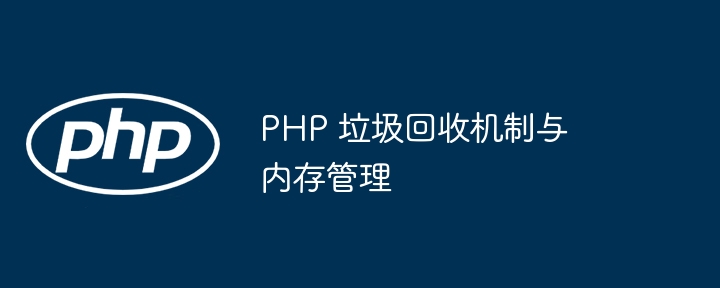PHP garbage collection mechanism and memory management
PHP's memory management uses a garbage collection mechanism, which automatically releases unused memory at runtime and operates based on the principle of reference counting. To avoid memory leaks, follow these best practices: destroy variables no longer needed, avoid circular references, and use weak references.

PHP garbage collection mechanism and memory management
Memory management in PHP
PHP uses a garbage collection mechanism to manage memory, which means Then it will automatically release memory that is no longer used at runtime. Garbage collection is handled by the PHP interpreter, so developers generally do not need to manually manage memory.
The principle of garbage collection
PHP’s garbage collection is based on reference counting. Each PHP variable maintains a reference counter that tracks the number of variables and objects that reference it. When the reference counter reaches 0, it means that the variable is no longer used, and the PHP interpreter will automatically release the memory occupied by the variable.
Example
To demonstrate the garbage collection mechanism, let us create a simple PHP script:
<?php $obj = new stdClass(); $obj->name = "John Doe"; // 将对象的引用传递给另一个变量 $ref1 = $obj; // 再将对象的引用传递给另一个变量 $ref2 = $obj; // 销毁第一个引用 unset($ref1); // PHP 解释器会自动释放对象占用的内存,因为现在只剩下一个引用计数
Avoid memory leaks
Although the garbage collection mechanism automatically releases memory, but there is still a possibility of memory leaks. A memory leak is when a reference to a variable or object that is no longer used is retained, preventing the PHP interpreter from releasing the memory.
To avoid memory leaks, follow these best practices:
- Destroy variables no longer needed: Use the
unset()function to release references to variables . - Avoid circular references: Two or more objects reference each other, causing the reference counter to fail to return to zero.
- Use weak references: If you need to retain an object reference but do not want to prevent garbage collection, you can use weak references.
Practical Case
Let us use the previous script to create a practical case to demonstrate the garbage collection mechanism:
<?php
class MyClass
{
public $data;
public function __destruct()
{
echo "释放 MyClass 实例\n";
}
}
$obj = new MyClass();
$obj->data = "一些数据";
// 将对象的引用传递给另一个变量
$ref = $obj;
// 销毁第一个引用
unset($obj);
// PHP 解释器会自动释放对象占用的内存,因为现在只剩下一个引用计数
echo "脚本结束\n";Running this script will print the following output:
释放 MyClass 实例 脚本结束
This indicates that the PHP interpreter automatically releases the memory occupied by the MyClass instance at the end of the script.
The above is the detailed content of PHP garbage collection mechanism and memory management. For more information, please follow other related articles on the PHP Chinese website!

Hot AI Tools

Undresser.AI Undress
AI-powered app for creating realistic nude photos

AI Clothes Remover
Online AI tool for removing clothes from photos.

Undress AI Tool
Undress images for free

Clothoff.io
AI clothes remover

AI Hentai Generator
Generate AI Hentai for free.

Hot Article

Hot Tools

Notepad++7.3.1
Easy-to-use and free code editor

SublimeText3 Chinese version
Chinese version, very easy to use

Zend Studio 13.0.1
Powerful PHP integrated development environment

Dreamweaver CS6
Visual web development tools

SublimeText3 Mac version
God-level code editing software (SublimeText3)

Hot Topics
 CakePHP Project Configuration
Sep 10, 2024 pm 05:25 PM
CakePHP Project Configuration
Sep 10, 2024 pm 05:25 PM
In this chapter, we will understand the Environment Variables, General Configuration, Database Configuration and Email Configuration in CakePHP.
 PHP 8.4 Installation and Upgrade guide for Ubuntu and Debian
Dec 24, 2024 pm 04:42 PM
PHP 8.4 Installation and Upgrade guide for Ubuntu and Debian
Dec 24, 2024 pm 04:42 PM
PHP 8.4 brings several new features, security improvements, and performance improvements with healthy amounts of feature deprecations and removals. This guide explains how to install PHP 8.4 or upgrade to PHP 8.4 on Ubuntu, Debian, or their derivati
 CakePHP Date and Time
Sep 10, 2024 pm 05:27 PM
CakePHP Date and Time
Sep 10, 2024 pm 05:27 PM
To work with date and time in cakephp4, we are going to make use of the available FrozenTime class.
 CakePHP File upload
Sep 10, 2024 pm 05:27 PM
CakePHP File upload
Sep 10, 2024 pm 05:27 PM
To work on file upload we are going to use the form helper. Here, is an example for file upload.
 CakePHP Routing
Sep 10, 2024 pm 05:25 PM
CakePHP Routing
Sep 10, 2024 pm 05:25 PM
In this chapter, we are going to learn the following topics related to routing ?
 Discuss CakePHP
Sep 10, 2024 pm 05:28 PM
Discuss CakePHP
Sep 10, 2024 pm 05:28 PM
CakePHP is an open-source framework for PHP. It is intended to make developing, deploying and maintaining applications much easier. CakePHP is based on a MVC-like architecture that is both powerful and easy to grasp. Models, Views, and Controllers gu
 CakePHP Creating Validators
Sep 10, 2024 pm 05:26 PM
CakePHP Creating Validators
Sep 10, 2024 pm 05:26 PM
Validator can be created by adding the following two lines in the controller.
 CakePHP Working with Database
Sep 10, 2024 pm 05:25 PM
CakePHP Working with Database
Sep 10, 2024 pm 05:25 PM
Working with database in CakePHP is very easy. We will understand the CRUD (Create, Read, Update, Delete) operations in this chapter.






